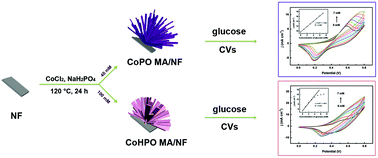Controlled synthesis of flower-like cobalt phosphate microsheet arrays supported on Ni foam as a highly efficient 3D integrated anode for non-enzymatic glucose sensing†
Abstract
Cobalt phosphate (CoPO) is gaining increasing interest as an alternative to noble metals in electrocatalytic applications. Here, we report the controlled synthesis of flower-like CoPO microsheet arrays supported on Ni foam (CoPO MA/NF) via a simple hydrothermal reaction, and their direct use as a 3D integrated anode for non-enzymatic glucose sensing. The catalytic activity of CoPO MA/NF towards glucose oxidation was evaluated by electrochemical tests. Results show that CoPO MA/NF displays high performance for glucose sensing with a short response time of less than 10 s, a low detection limit of 1 μM (S/N = 3), and a high sensitivity of 3.55 mA mM−1 cm−2. In addition, CoPO MA/NF shows excellent selectivity in the presence of interfering agents such as dopamine, uric acid and ascorbic acid, which makes it reliable for glucose detection in real human serum samples. This work not only provides the controlled synthesis of a CoPO 3D integrated electrode by a simple process, but also explores the potential application of the CoPO-based electrode material for electrochemical sensing of biochemical analytes.



 Please wait while we load your content...
Please wait while we load your content...